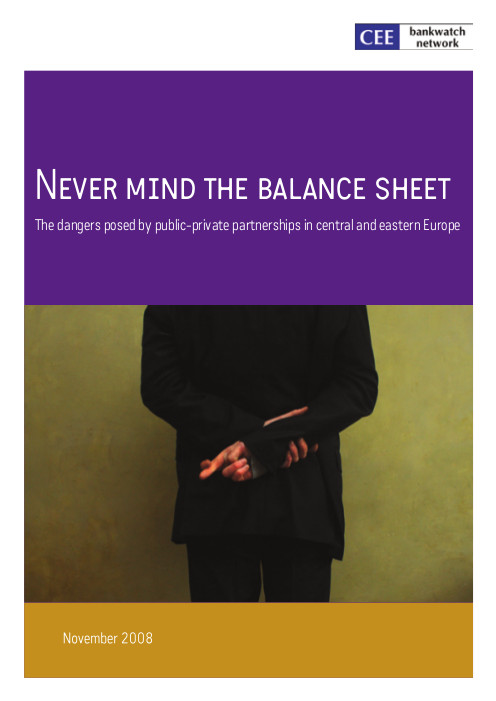Never Mind the Balance Sheet: The Dangers Posed by Public-Private Partnerships in Central and Eastern Europe (2008)
Filed under report | Tags: · central europe, commons, east-central europe, eastern europe, finance, public-private partnership

In recent years public-private partnerships (PPPs) have been heavily promoted in central and eastern Europe (CEE), often giving the impression that where infrastructure is concerned, PPPs are the only game in town. Yet behind the plethora of conferences, workshops and publications, few CEE countries have implemented more than two or three PPP projects, and even fewer truly successful projects.
As George Monbiot, UK author and investigative journalist, says of the Private Finance Initiative, the British variant on PPP: “The reality is that PFI, or public private partnership as the government now prefers to call it, is a scam. (…) Far from introducing market disciplines, it has become an official licence to fleece the taxpayer. Far from reducing the public sector borrowing requirement, PFI is, as the Accounting Standards Board has noted, simply an an off-balance sheet fiddle. Most alarmingly, the ministers I have spoken to simply do not understand how it works.”
Research and writing: Fidanka Bacheva-McGrath, Eliska Cisarova, Akos Eger, Pippa Gallop, Zvezdan Kalmar, Vera Ponomareva
Publisher CEE Bankwatch Network, November 2008
Creative Commons Attribution-NonCommercial-NoDerivs License
60 pages
The Hidden Costs of of Public-Private Partnerships online resource
PDF
PDF (shorter versions in more languages)
Nordics in Global Crisis: Vulnerability and Resilience (2010)
Filed under report | Tags: · banking, economy, finance, financial crisis, nordics, scandinavia

The world is experiencing its worst slump since the Great Depression in the 1930s. The Nordic countries have, with the exception of Norway, been hit harder than most. Due to its sharpness and depth, the crisis is opening up or reviving a broad agenda of important policy issues. This report raises a number of the issues and discusses the scope for economic policies to contribute to the resolution of key economic problems.
The report can be seen as a sequel and as complementary to an earlier report on the Nordic Model, presented two years earlier by a team including three of the authors of the present report. While the earlier report was focused on structural issues, the one at hand is about macroeconomic and financial issues.
The members of the team are eminent economists and authoritative experts on the issues covered. The report is a joint product, reflecting
Authors Thorvaldur Gylfason, Bengt Holmström, Sixten Korkman, Hans Tson Söderström, Vesa Vihriälä
Publisher Taloustieto Oy, Helsinki, 2010
Volume 242 of ETLA – The Research Institute of the Finnish Economy. Series B
ISBN 9516284957, 9789516284951
264 pages
Detlev S. Schlichter: Paper Money Collapse: The Folly of Elastic Money and the Coming Monetary Breakdown (2011)
Filed under book | Tags: · banking, economics, economy, finance, money

The case for the inevitable failure of a paper money economy and what that means for the future
All paper money systems in history have ended in failure. Either they collapsed in chaos, or society returned to commodity money before that could happen. Drawing upon novel new research, Paper Money Collapse conclusively illustrates why paper money systems—those based on an elastic and constantly expanding supply of money as opposed to a system of commodity money of essentially fixed supply—are inherently unstable and why they must lead to economic disintegration.
These highly controversial conclusions clash with the present consensus, which holds that elastic state money is superior to inflexible commodity money (such as a gold standard), and that expanding money is harmless or even beneficial for as long as inflation stays low. Contradicting this, Paper Money Collapse shows that:
– The present crisis is the unavoidable result of continuously expanding fiat money
– The current policy of accelerated money production to “stimulate” the economy is counterproductive and could lead to a complete collapse of the monetary system
– Why many in financial markets, in media, and in the policy establishment are unable (and often unwilling) to fully appreciate the underlying problems with elastic money.
This compelling new book looks at the breakdown of modern economic theory and the fallacy of mathematical models. It is an analysis of the current financial crisis and shows in very stark terms that the solutions presented by paper money-enthusiasts around the world are misguided and inherently flawed.
Foreword by Addison Wiggin
Publisher John Wiley & Sons, 2011
ISBN 1118095751, 9781118095751
240 pages

